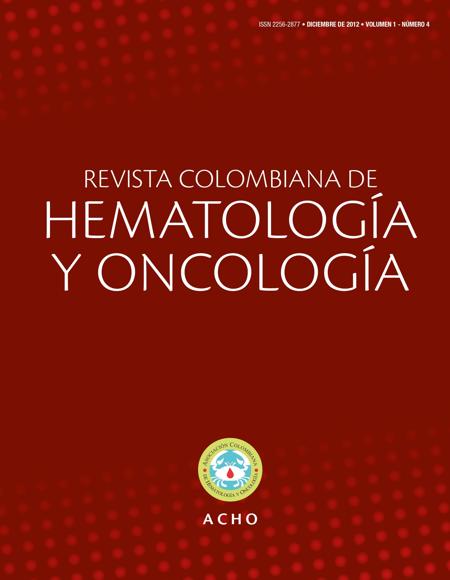Sensibilidad del TTPa en la detección de una deficiencia de factores de coagulación.
aPTT sensitivity in the detection of coagulation factors deficiency.

Cómo citar
Descargar cita

Esta obra está bajo una licencia internacional Creative Commons Atribución-NoComercial-CompartirIgual 4.0.
Mostrar biografía de los autores
Objetivos: Determinar la sensibilidad del TTPa con el reactivo Actin FSL para la detección de pacientes con déficit de factores de coagulación comparada con el estándar de referencia, que es la determinación directa del nivel de actividad de factores de coagulación por método coagulométrico de un paso. Métodos: Población: pacientes del Hospital Militar Central (Bogotá, Colombia) con determinación de TTPa por Actin FSL y de niveles de factores de coagulación solicitados por sospecha de trastornos de hemostasia durante el período de junio del 2009 a febrero del 2011. Tipo de estudio: analítico de corte transversal de validación de pruebas diagnósticas. A todos los pacientes se les aplicó la prueba por evaluar, TTPa con Actin FSL y el estándar de referencia, de manera independiente a sus resultados. Resultados: De junio del 2009 a febrero del 2011, se incluyeron 133 pacientes con realización de TTPa por Actin FSL y medición de factores de coagulación de manera concomitante. En la población total estudiada, la sensibilidad del TTPa fue del 98.7% con un LR- de 0.02. Ningún paciente con deficiencia severa de factores de coagulación (definida como un valor < 1%) presentó un valor de TTPa < 32.1 seg. El análisis por regresión lineal demostró que no existe relación entre el porcentaje de actividad de los factores de coagulación y el valor del TTPa en segundos. Conclusiones: El TTPa con Actin FSL bajo una técnica estandarizada tiene alta sensibilidad en la detección de disminución de factores de coagulación, y un resultado normal hace muy improbable encontrar déficit de algún factor, por determinación directa.
Visitas del artículo 344 | Visitas PDF 586
Descargas
- Proctor RR, Rapaport SI. The partial thromboplastin time with kaolin. A simple screening test for first stage plasma clotting factor deficiencies. Am J Clin Pathol. 1961;36:212-9.
- Chee YL, Crawford JC, Watson HG, Greaves M. Guidelines on the assessment of bleeding risk prior to surgery or invasive procedures. British Committee for Standards in Haematology. Br J Haematol. 2008;140(5):496-504.
- Pengo V, Tripodi A, Reber G, Rand JH, Ortel TL, Galli M, et al. Update of the guidelines for lupus anticoagulant detection. Subcommittee on Lupus Anticoagulant/Antiphospholipid Antibody of the Scientific and Standardisation Committee of the International Society on Thrombosis and Haemostasis. J Thromb Haemost. 2009;7(10):1737-40.
- Kitchen SM, Echenagucia M. Diagnosis of hemophilia and other bleeding disorders. Montréal, Québec: the World Federation of Hemophilia (WFH); 2010.
- Bowyer A, Smith J, Woolley AM, Kitchen S, Hampton KK, Maclean RM, et al. The investigation of a prolonged APTT with specific clotting factor assays is unnecessary if an APTT with Actin FS is normal. Int J Lab Hematol. 2011;33(2):212-8.
- Brandt JT, Arkin CF, Bovill EG, Rock WA, Triplett DA. Evaluation of APTT reagent sensitivity to factor IX and factor IX assay performance. Results from the College of American Pathologists Survey Program. Arch Pathol Lab Med. 1990;114(2):135-41.
- Shetty S, Ghosh K, Mohanty D. Comparison of four commercially available activated partial thromboplastin time reagents using a semi-automated coagulometer. Blood Coagul Fibrinolysis. 2003;14(5):493-7.
- Lawrie AS, Kitchen S, Purdy G, Mackie IJ, Preston FE, Machin SJ. Assessment of Actin FS and Actin FSL sensitivity to specific clotting factor deficiencies. Clin Lab Haematol. 1998;20(3):179-86.
- Bowyer A, Kitchen S, Makris M. The responsiveness of different APTT reagents to mild factor VIII, IX and XI deficiencies. Int J Lab Hematol. 2011;33(2):154-8.
- White GC 2nd, Rosendaal F, Aledort LM, Lusher JM, Rothschild C, Ingerslev J. Definitions in hemophilia. Recommendation of the scientific subcommittee on factor VIII and factor IX of the scientific and standardization committee of the International Society on Thrombosis and Haemostasis. Thromb Haemost. 2001;85(3):560.
- Chng WJ, Sum C, Kuperan P. Causes of isolated prolonged activated partial thromboplastin time in an acute care general hospital. Singapore Med J. 2005;46(9):450-6.
- Girolami A, Luzzatto G, Varvarikis C, Pellati D, Sartori R, Girolami B. Main clinical manifestations of a bleeding diathesis: an often disregarded aspect of medical and surgical history taking. Haemophilia. 2005;11(3):193-202.
- Favaloro EJ. Investigating people with mucocutaneous bleeding suggestive of primary hemostatic defects: a low likelihood of a definitive diagnosis? Haematologica. 2007;92(3):292-6.
- Kamal AH, Tefferi A, Pruthi RK. How to interpret and pursue an abnormal prothrombin time, activated partial thromboplastin time, and bleeding time in adults. Mayo Clin Proc. 2007;82(7):864-73.
- Ng VL. Prothrombin time and partial thromboplastin time assay considerations. Clin Lab Med. 2009;29(2):253-63.
- Ten Boekel E, Bock M, Vrielink GJ, Liem R, Hendriks H, de Kieviet W. Detection of shortened activated partial thromboplastin times: an evaluation of different commercial reagents. Thromb Res. 2007;121(3):361-7.
- Li J, Lai X, Yan C, Xu A, Nie L, Zhou Y, et al. Age-associated developmental changes in the activated partial thromboplastin time (APTT) and causes of prolonged APTT values in healthy Chinese children. Clin Chem Lab Med. 2009;47(12):1531-7.

















